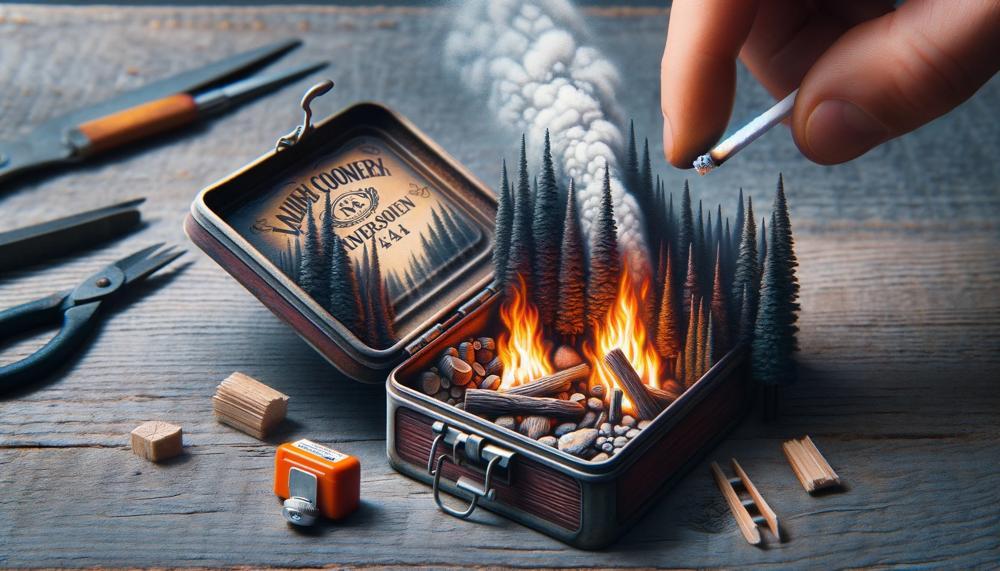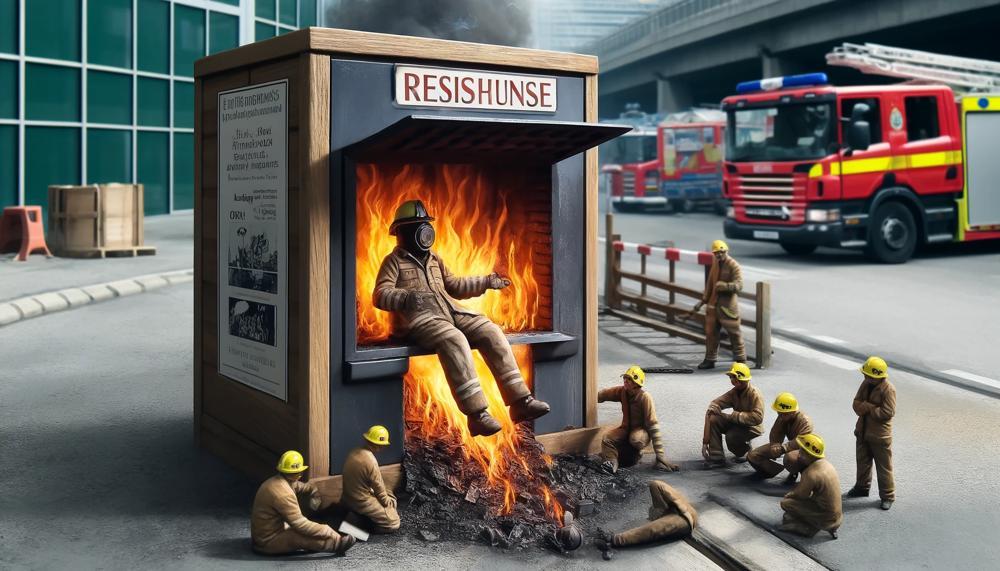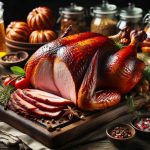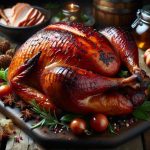Imagine a perfect summer day – clear blue skies, warm sunshine, and the mouth-watering aroma of barbecue filling the air. You’ve put in hours of preparation for this moment – carefully selecting your meat, marinating it to perfection, and setting up your smoker.
But as you start cooking, you notice your fire is dwindling and your meat isn’t cooking evenly. Before you panic, know that maintaining a smoker fire doesn’t have to be intimidating.
So, how do you maintain a smoker fire?
Maintaining a fire in a smoker involves managing the airflow and fuel source. Here are some steps to help you maintain a smoker fire:
- Choose the Right Wood: Use hardwood that bears a fruit or a nut, and avoid pine or other softwoods that produce bad smoke.
- Prepare the Wood: Split and cut the wood to the appropriate size for your smoker.
- Build a Fire: Build a lattice structure of wood in the firebox, and light it.
- Manage Airflow: Open the doors of the smoker to allow maximum airflow, and wait for the fire to produce clean smoke.
- Monitor the Temperature: Use a wireless probe to maintain the temperature within a 50-degree range.
- Add Fuel Regularly: Add preheated splits when the fire starts to die down or the temperature drops.
- Use Long-Handled Tongs: Use long-handled tongs to rearrange the coals and shake off the ash.
- Preheat the Wood: Preheat the wood on the firebox if needed.
- Clean the Ashes: When done cooking, open everything up and let the fire burn itself out, then clean the ashes the next day.
By following these tips, you can keep your smoker fire going strong all day long. So go ahead and enjoy that delicious barbecue without any worries.
Contents
How Do You Maintain A Smoker Fire?
Tips for maintaining a steady and consistent fire in a smoker for the best BBQ results include starting with a strong burning fire, using properly seasoned wood, monitoring the temperature, and keeping a close eye on the fire.
Begin with a strong burning fire:
To achieve and maintain a steady and consistent fire in your smoker, it is crucial to start with a strong burning fire. Use charcoal or kindling to ignite the fire and then close the firebox door to trap the heat.
Use well-seasoned wood:
The type of wood you use is essential for both flavor and safety reasons. Make sure to use well-seasoned wood to avoid contaminating your food with creosote from dirty smoke. It will also help in producing clean and flavorful smoke.
Monitor the temperature:
Keeping an eye on the temperature is vital in maintaining a consistent fire in your smoker.
The ideal smoking temperature is between 225-250 degrees Fahrenheit. Use a thermometer to monitor the temperature and make necessary adjustments to keep it consistent.
Keep an eye on the fire:
During the smoking process, it is essential to keep a close eye on the fire to ensure it does not die out. Check the fuel level regularly and add more charcoal or wood as needed to maintain a steady and consistent fire.
Adjust dampers and flue:
To maintain a stable temperature in your smoker, it is essential to adjust the dampers and flue accordingly. Keeping them open will allow oxygen to feed the flames, while closing them will help trap heat and maintain the desired temperature.
Add wood chips for smoke production:
To produce smoke, you will need to add wood chips to your fire periodically.
Soak the wood chips in water for at least 30 minutes before adding them to your fire to prevent them from burning too quickly and producing thick white smoke.
Use a water pan:
Placing a water pan in your smoker can help maintain a consistent fire and temperature.
The water will evaporate and help regulate the internal temperature of the smoker, preventing it from getting too high.
Keep the firebox clean:
Regularly cleaning the firebox during the smoking process is essential to maintain a steady and consistent fire.
Remove any ash or debris to ensure even heat distribution and prevent any unwanted flavors from transferring onto your food.
Understanding the Different Types of Smokers
To truly master the art of smoking food, it is important to have a good understanding of the different types of smokers available. From offset smokers to cold smokers, each has its own unique features and benefits.
Let’s take a closer look at some popular types:
- Offset Smokers: These feature a designated firebox on the side which allows for better temperature control.
- Vertical Smokers: Grilling grates are stacked vertically in these smokers for even heat distribution.
- Propane Smokers: These smokers use propane gas as fuel, which can be convenient for those who prefer a quick and easy setup.
- Electric Smokers: As the name suggests, these smokers use electricity to produce heat, making them user-friendly but potentially lacking in smoke flavor.
- Pellet Smokers: These smokers use wood pellets as fuel and are known for their consistent heat and smoke production.
- Charcoal Smokers: Using charcoal as fuel, these smokers can produce intense smoky flavors and are often more affordable.
- Kamado Smokers: These are ceramic smokers that offer superior insulation and temperature control.
- Kettle Grills: While primarily used for grilling, kettle grills can also be used for smoking by adding wood chips.
- Cold Smokers: These specialized smokers are designed for cold smoking, which is a process that infuses food with a smoky flavor without cooking it.
Preparing Your Smoker for Use
- Familiarize yourself with your smoker: Before starting, it’s essential to have a good understanding of the different components of your smoker and how they work together. This includes the firebox, cooking chamber, airflow vents, and temperature gauge.
- Select the right fuel: Depending on personal preference, you can use charcoal, wood, or a combination of both to fuel your smoker. Keep in mind that different types of wood will impart unique flavors to your food.
- Inspect and clean your smoker: Prior to lighting the fire, thoroughly check and clean your smoker. This ensures that there are no residual ashes or debris that could impact the taste of your food.
- Ensure proper ventilation: Adequate ventilation is crucial for maintaining a consistent temperature in your smoker. Before lighting the fire, make sure all vents are open.
- Enhance flavor with wood chips: Soaked or dry wood chips can be added to the fire to infuse your food with a desired smoky flavor.
- Preheat your smoker: Open all vents and the firebox damper to preheat your smoker. This helps regulate temperature and creates an evenly heated cooking environment.
- Light the fire: There are two methods for lighting a fire in a smoker – direct and indirect lighting. You can use a chimney starter or place charcoal and wood directly in the firebox.
- Manage the fire: Once the fire is lit, adjust vents as needed to regulate airflow and add wood chunks periodically to maintain desired smoke levels.
- Maintain temperature: Use a thermometer to monitor the internal temperature of the smoker and make necessary adjustments to keep it consistent.
- 10. Properly prepare food: Before placing food in the smoker, be sure to season or marinate it properly for maximum flavor.
- 1Troubleshoot common issues: If you encounter changes in temperature, excessive smoke, or uneven cooking, try adjusting vents or adding more wood chunks.
- 1Clean and maintain your smoker: After each use, clean and maintain your smoker to ensure it is always ready for your next smoking session.
- 1Avoid accelerants: Resist the temptation to use lighter fluid or other accelerants when lighting the fire, as they can alter the taste of your food.
- 1Preheat time and fuel management: Depending on the size of your smoker and desired temperature, preheating time can range from 20 minutes to an hour.
Choosing the Right Wood for Smoking
Choosing the perfect wood for smoking is essential in achieving consistent levels of heat and smoke in your smoker. As previously mentioned, hardwoods are the top choice for maintaining a steady fire due to their density and low sap content. Let’s take a closer look at some specific types of hardwood that are excellent for smoking.
- Oak – Considered one of the most popular woods for smoking, oak offers a robust and smoky flavor that pairs well with various meats. It also burns slowly and evenly, making it an ideal option for maintaining a consistent fire.
- Maple – Another top choice, maple wood has a mild and slightly sweet taste that complements poultry and pork. It also produces a steady and consistent burn, making it a reliable choice for smokers.
- Apple – Known for its fruity and sweet aroma, apple wood is a favorite among BBQ enthusiasts for smoking pork, poultry, and fish. It burns relatively quickly, which can be beneficial in maintaining temperature during longer smoking sessions.
- Pecan – With its strong and rich flavor, pecan wood is perfect for smoking red meats like beef and lamb. It also provides a consistent burn that helps maintain heat in your smoker.
- Cherry – Adding a touch of sweetness and fruitiness to smoked meats, cherry wood is a popular pick for pork and chicken. It also produces a steady burn that aids in temperature maintenance in your smoker.
Aside from these specific hardwood types, other fruit woods such as peach, pear, and plum can also contribute unique flavors to your smoked meats while providing a consistent burn.
Building and Monitoring Your Fire
Building and monitoring a successful fire in a smoker requires careful attention and proper techniques to achieve the perfect balance of heat and smoke. Achieving this balance can be a perplexing task, but by following these steps and techniques, you can create a burst of flavors that will leave your taste buds tingling with delight.
Now, let’s dive into the key steps for building and monitoring your fire in a smoker.
Pick the Perfect Hardwood:
The type of hardwood you choose can have a significant impact on the flavor and burn of your fire.
Oak, maple, apple, pecan, and cherry are all excellent options that offer unique flavors and steady burns. It is essential to make sure that the wood is seasoned and dry for the best results.
Start Strong with Charcoal or Kindling:
There are two ways to start a fire in a smoker: with charcoal or with kindling and small pieces of dry wood.
While both methods have their advantages, keep in mind that using charcoal may give your fire a more uniform length while using kindling allows for more burstiness in your fire as you intersperse short pieces of wood.
Utilize the Teepee Technique:
If you choose to use kindling, creating a teepee with long slivers of wood and lighting paper underneath is an excellent method to ensure proper airflow for igniting the fire.
As the fire grows, remember to add smaller pieces of dry wood first before gradually adding larger pieces to maintain the desired heat and smoke levels.
Keep Feeding the Fire:
To maintain a steady temperature and enhance the flavor of your BBQ, continuously add seasoned, dry wood every hour. This will also ensure a consistent amount of smoke throughout the smoking process.
Adjust Airflow Settings:
Controlling the heat and smoke levels in your smoker is crucial for achieving perfect results.
To adjust these levels, you can use intake and smoke stack settings accordingly.
Monitor the Temperature:
Keeping an eye on the temperature inside your smoker using a thermometer is vital.
It is recommended to maintain a temperature between 225-275 degrees Fahrenheit for most types of meat.
Enhance Flavor with Jeff’s BBQ Products:
For an added boost of flavor and convenience, consider using Jeff’s Golden Driller Sauce, BBQ sauce, Original Rub, or Texas-style Rub from Smoking-Meat.com.
These products are specially designed for BBQ enthusiasts and are available for purchase on the website.

By following these steps and techniques, you can ensure a successful fire in your smoker and achieve delicious, perfectly smoked meat every time.
Don’t forget to experiment with different hardwoods and techniques to find what works best for you.
Adding Wood Chips for Smoke Production
When it comes to producing the perfect smoky flavor for your meats, adding wood chips to a smoker is an essential step. But how often should you add wood chips to the fire to ensure optimal smoke production? Let’s delve into some key factors to consider.
Firstly, it is crucial to select the right type of hardwood for smoking. Popular options include hickory, mesquite, apple, and cherry wood. Each type of wood imparts a unique and distinct flavor to the meat, so choose according to your personal preference.
After choosing your wood, start by creating a fire in your smoker using either charcoal or kindling. This will serve as the base for your wood chips. Next, use the teepee technique to arrange your wood chips around the fire, allowing for proper airflow and consistent burning.
Now, it’s time to continuously feed the fire with more wood chips. It is recommended to add two to three handfuls of wood chips every hour. This will ensure a steady stream of smoke throughout the cooking process.
Another important aspect is adjusting the airflow settings on your smoker. Too much air can cause the wood chips to burn too quickly, while too little air can result in smoldering and less smoke production. It is crucial to monitor the temperature and adjust accordingly to maintain a consistent flow of smoke.
In terms of enhancing flavor, adding Jeff’s BBQ products can elevate your smoked meats to a whole new level. From rubs to sauces, these products are designed specifically for BBQ enthusiasts looking for that perfect balance of flavor.
So, for optimal smoke production, it is recommended to add wood chips every 0- minutes. By selecting the right type of hardwood, maintaining a steady fire with proper airflow, and using high-quality BBQ products, you can achieve that coveted smoky flavor in your meats.
Keeping an Eye on the Fire While Smoking
During the smoking process, it is highly recommended to keep an eye on the fire every 30 minutes for traditional smokers and every hour for pellet smokers. It’s crucial to be aware of the signs that indicate the progress of your smoke, including temperature readings, smoke color, sound, and weather conditions.
Traditionally, smokers are known for their slow and steady cooking method, which requires frequent monitoring to produce delicious and tender meats. While pellet smokers offer a more automated approach, it is still essential to check in periodically to ensure everything is running smoothly.
When keeping an eye on the fire, make sure to pay attention to the temperature reading. This will give you an idea of how fast or slow your meat is cooking and whether any adjustments need to be made. Additionally, take note of the smoke color, as it can provide valuable insight into how much smoke is being produced and if it needs to be adjusted.
The sound of your smoker can also reveal important information about its performance. A healthy smoker should produce a steady hum or low rumble. If you hear any unusual noises, it could indicate an issue with the smoker that needs to be addressed.
Lastly, consider the weather conditions when checking on your fire. Wind, rain, and other elements can affect the temperature and smoke production of your smoker. Be sure to make necessary adjustments accordingly.
Conclusion
Finally, keeping a smoker’s fire going might seem hard, but it’s not hard at all if you know what to do. To ensure a strong and stable fire, you must start by using good fuel and building a solid base of coal.
Monitoring the temperature and adding small amounts of fuel can help you maintain the ideal heat level when smoking. For your smoker to work at its best, don’t forget to make changes to the air and clean it often.
To get the perfect BBQ taste, you also need to pick the right type of grill and wood for cooking.
Also, don’t forget to check on your fire every 30 minutes to an hour. Pay attention to changes in temperature, smoke color, sound, and weather. Following these tips will help you enjoy a delicious barbecue on a lovely summer day without having to worry about your grill fire.






